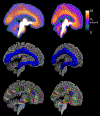Serotonin transporter binding in major depressive disorder: impact of serotonin system anatomy
- PMID: 35487966
- PMCID: PMC9616969
- DOI: 10.1038/s41380-022-01578-8
Serotonin transporter binding in major depressive disorder: impact of serotonin system anatomy
Abstract
Serotonin transporter (5-HTT) binding deficits are reported in major depressive disorder (MDD). However, most studies have not considered serotonin system anatomy when parcellating brain regions of interest (ROIs). We now investigate 5-HTT binding in MDD in two novel ways: (1) use of a 5-HTT tract-based analysis examining binding along serotonergic axons; and (2) using the Copenhagen University Hospital Neurobiology Research Unit (NRU) 5-HT Atlas, based on brain-wide binding patterns of multiple serotonin receptor types. [11C]DASB 5-HTT PET scans were obtained in 60 unmedicated participants with MDD in a current depressive episode and 31 healthy volunteers (HVs). Binding potential (BPP) was quantified with empirical Bayesian estimation in graphical analysis (EBEGA). Within the [11C]DASB tract, the MDD group showed significantly lower BPP compared with HVs (p = 0.02). This BPP diagnosis difference also significantly varied by tract location (p = 0.02), with the strongest MDD binding deficit most proximal to brainstem raphe nuclei. NRU 5-HT Atlas ROIs showed a BPP diagnosis difference that varied by region (p < 0.001). BPP was lower in MDD in 3/10 regions (p-values < 0.05). Neither [11C]DASB tract or NRU 5-HT Atlas BPP correlated with depression severity, suicidal ideation, suicide attempt history, or antidepressant medication exposure. Future studies are needed to determine the causes of this deficit in 5-HTT binding being more pronounced in proximal axon segments and in only a subset of ROIs for the pathogenesis of MDD. Such regional specificity may have implications for targeting antidepressant treatment, and may extend to other serotonin-related disorders.
© 2022. The Author(s), under exclusive licence to Springer Nature Limited.
Conflict of interest statement
Figures




Similar articles
-
Imaging the serotonin transporter during major depressive disorder and antidepressant treatment.J Psychiatry Neurosci. 2007 Mar;32(2):86-102. J Psychiatry Neurosci. 2007. PMID: 17353938 Free PMC article. Review.
-
In vivo serotonin transporter and 1A receptor binding potential and ecological momentary assessment (EMA) of stress in major depression and suicidal behavior.Eur Neuropsychopharmacol. 2023 May;70:1-13. doi: 10.1016/j.euroneuro.2023.01.006. Epub 2023 Feb 11. Eur Neuropsychopharmacol. 2023. PMID: 36780841 Free PMC article.
-
Brain serotonin transporter binding, plasma arachidonic acid and depression severity: A positron emission tomography study of major depression.J Affect Disord. 2019 Oct 1;257:495-503. doi: 10.1016/j.jad.2019.07.035. Epub 2019 Jul 5. J Affect Disord. 2019. PMID: 31319341 Free PMC article.
-
Positron emission tomography quantification of serotonin transporter binding in medication-free bipolar disorder.Synapse. 2016 Jan;70(1):24-32. doi: 10.1002/syn.21868. Epub 2015 Oct 19. Synapse. 2016. PMID: 26426356 Free PMC article.
-
Genetics of the serotonergic system in suicidal behavior.J Psychiatr Res. 2003 Sep-Oct;37(5):375-86. doi: 10.1016/s0022-3956(03)00048-7. J Psychiatr Res. 2003. PMID: 12849930 Review.
Cited by
-
Association between serum copper, zinc, and selenium concentrations and depressive symptoms in the US adult population, NHANES (2011-2016).BMC Psychiatry. 2023 Jul 11;23(1):498. doi: 10.1186/s12888-023-04953-z. BMC Psychiatry. 2023. PMID: 37434135 Free PMC article.
-
Structural brain changes in the anterior cingulate cortex of major depressive disorder individuals with suicidal ideation: Evidence from the REST-meta-MDD project.Psychol Med. 2025 Feb 7;55:e24. doi: 10.1017/S0033291724003283. Psychol Med. 2025. PMID: 39916347 Free PMC article.
-
Serotonin Receptors in Areas of the Emotion Regulation Network in Human and Rat Brains-A Comparative Autoradiographic Study.J Comp Neurol. 2025 Jul;533(7):e70068. doi: 10.1002/cne.70068. J Comp Neurol. 2025. PMID: 40671067 Free PMC article.
-
Associations of serotonin-related brain morphology in early adolescence with behavioral and emotional problems.Neuroimage Clin. 2025 Jul 28;48:103851. doi: 10.1016/j.nicl.2025.103851. Online ahead of print. Neuroimage Clin. 2025. PMID: 40752113 Free PMC article.
-
Translational bioinformatics and data science for biomarker discovery in mental health: an analytical review.Brief Bioinform. 2024 Jan 22;25(2):bbae098. doi: 10.1093/bib/bbae098. Brief Bioinform. 2024. PMID: 38493340 Free PMC article. Review.
References
-
- Owens MJ, Nemeroff CB. Role of serotonin in the pathophysiology of depression: focus on the serotonin transporter. Clin Chem 1994; 40(2): 288–295. - PubMed
-
- Kambeitz JP, Howes OD. The serotonin transporter in depression: Meta-analysis of in vivo and post mortem findings and implications for understanding and treating depression. Journal of affective disorders 2015; 186: 358–366. - PubMed
-
- Parsey RV, Hastings RS, Oquendo MA, Huang Y-y, Simpson N, Arcement J et al. Lower serotonin transporter binding potential in the human brain during major depressive episodes. American Journal of Psychiatry 2006; 163(1): 52–58. - PubMed
-
- Selvaraj S, Murthy NV, Bhagwagar Z, Bose SK, Hinz R, Grasby PM et al. Diminished brain 5-HT transporter binding in major depression: a positron emission tomography study with [11 C] DASB. Psychopharmacology 2011; 213(2–3): 555–562. - PubMed
Publication types
MeSH terms
Substances
Grants and funding
LinkOut - more resources
Full Text Sources

